Our smiles radiate our happiness, confidence, and vitality. What happens when we lose our precious pearly whites to time or accidents, and the gleaming grin fades?
In the past, patients resigned themselves to traditional tooth replacement methods, accepting the inevitable aesthetic and practical constraints. But, there is a revolution taking place in the dental world, a revolution that opens new horizons and unlocks a superior quality of life. The key lies in implant dentistry.
From 3D imaging and spatial diagnosis to the usage of advanced techniques that prioritize the end aesthetic result, dental implants have moved far beyond their previous scope. This fascinating journey enables patients to achieve a radiant, confident smile while maintaining optimal oral health. So, are you ready to unravel the astonishing advancements in implant dentistry and illuminate the path to your perfect smile?
Using CBCT Imagery and 3D Digital Data Diagnostic Tools in Implant Dentistry
In the field of implant dentistry, the advent of CBCT (Cone Beam Computed Tomography) imagery and 3D digital data diagnostic tools have revolutionized treatment planning. CBCT scans offer detailed insights into patients' anatomical structures, particularly bone density and quality. This information is critical for accurate and safe implant placement.
With the help of 3D digital data diagnostic tools, dental professionals can visualize a patient's oral cavity in three dimensions. This brings about an elevated level of precision in implant placement, which was unattainable with traditional 2D imaging methods. Furthermore, these modern diagnostic tools are non-invasive and convenient for both the practitioner and the patient.
The utilization of CBCT imagery and 3D digital data in implant treatment planning has led to improved accuracy and success rate, with fewer complications. As we progress further in exploring prosthetic-driven implant planning in the upcoming section, it becomes evident how critical these advanced technologies are in implant dentistry.
The Importance of Prosthetic-Driven Implant Planning
Prosthetic-driven implant planning is a critical component in the field of implant dentistry, ensuring optimal outcomes based on individualized requirements. This approach involves designing the final prosthetic restoration at the onset, and then planning the implant placement and angulation accordingly.
Benefits and Implementation
Unquestionably, this approach leads to enhanced functional and aesthetic outputs while maximizing patient satisfaction. The crucial interplay between the implant dentist and the restorative dentist ensures the planned implant location aligns perfectly with the prosthetic prerequisites.
Successful examples of prosthetic-driven planning abound in the field, providing long-lasting results and patient satisfaction. The utilization of advanced digital tools and techniques during the planning phase further bolsters predictability and streamlines the process.
Given its manifold advantages, prosthetic-driven planning should be considered a standard practice in implant dentistry. The path to optimal, patient-centric outcomes indeed lies in carefully crafted, prosthetic-oriented strategies.
Achieving Predictable Esthetic Outcomes in Implant Dentistry
The realm of implant dentistry has experienced significant advancements with digital imaging and virtual planning. These developments allow dental professionals to visualize final esthetic outcomes even before the onset of treatment.
Leading the charge in these practices is digital smile design software. This tool simulates the expected appearance of the patient's smile post-implant placement. From factoring in tooth size to color match and gingival contours, every aspect is taken into account to ensure a natural-looking result. This attention to detail reduces unexpected esthetic complications, bringing about enhanced patient satisfaction.
Consider, for example, a patient who was apprehensive about her treatment, but a demonstration of her potential post-procedure smile with the software put her at ease. This story underlines the importance of predictable esthetic outcomes in implant dentistry.
In conclusion, prioritizing esthetics in treatment planning is encouraged. With the aid of digital advancements and thorough planning, we can amplify patient satisfaction and cement our reputation in implant dentistry.
Unlocking the Potential: How to Plan Your Implant Treatment
The key to successful dental implant treatments lies in meticulous planning. The initial consultation phase, which includes a comprehensive oral examination and patient-specific assessments, is pivotal to the process. With the aid of state-of-the-art technologies like digital imaging and Cone Beam CT (CBCT) scans, indispensable details of your oral anatomy are gathered for precise implant placement.
A collaborative approach among dental professionals ensures the evaluation of every aspect of your treatment. This comprehensive collaboration between the implant dentist and other dental specialists, much like the prosthetic-driven implant planning discussed earlier, is employed to design an individualized treatment plan attuned to your needs and goals.
The use of virtual planning software allows for a visualization of the implant placement, minimizing surprises during the actual surgical procedure. In conclusion, patients considering implant dentistry should prioritize diligent planning and seek practices that use these advanced methodologies to ensure excellence in implant treatment outcomes.
For more info >> FACIAL IMAGING, 1219 Gravesend Neck Road Brooklyn, NY 11229

